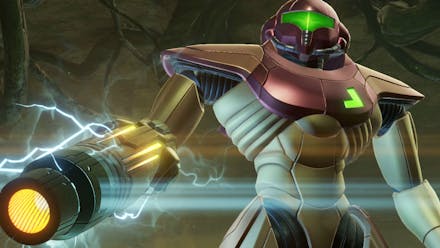Platforms: Switch
A remaster of 2002 GameCube classic Metroid Prime has long been rumoured, which made it all the odder that Nintendo ultimately chose to effectively sneak its release out, launching digitally immediately after its most recent Nintendo Direct broadcast (with a physical release to follow). Still, the surprise return of bounty hunter Samus Aran is a welcome one, and two decades on from its original release, Prime remains one of her finest adventures.
Metroid Prime was always a radical entry for the series, jettisoning the familiar 2D action platforming in favour of a full 3D, first person shooter approach. What’s as remarkable now as it was over two decades ago though is how much it still feels like a Metroid game, despite the shift in perspective. Developer Retro Studios (which handles the remaster with assistance from outside studios including Iron Galaxy and Zombot) could have gone the easy route and turned in a generic sci-fi shooter, but instead Samus’ journey across the abandoned world of Tallon IV packs in every bit as much puzzle solving, skilful navigation of tricky environments, and meticulous mapping of areas as fans of the series expected. The criss-crossing of imaginatively detailed environments as new power-ups are acquired, each allowing access to new locations or hidden caches, pulls players back and forth across the planet’s surface as compulsively as Samus’ classic 2D entries ever did. The 3D approach does change how some elements of combat work – being able to strafe around enemies while locked on, for instance – but at heart it’s as ‘pure’ an instalment as Super Metroid or Metroid Dread.

In terms of narrative and structure, Retro hasn’t changed anything from the GameCube version. This is still a captivating tale (set between the events of Metroid and Metroid II, for those keeping track) which finds Samus drawn to Tallon IV after uncovering a dangerous genetic engineering experiment being conducted by her enemies, the Space Pirates. Investigating the incident uncovers a fallen civilisation of the mysterious Chozo race, and their seemingly failed efforts to save the planet from the effects of an unknown energy source that has corrupted everything from water to wildlife. The physical layout of the world remains the same as in 2002, as does the arguably unforgiving save system. Save stations are just rare enough that there’s always tension over whether you’ll make it back to one after finally beating a tough boss or acquiring a much-needed power-up, without being taken out by the planet’s hostile inhabitants.
Retro Studios and its partners have done real justice to a rightly beloved classic.
The big differences for Metroid Prime in 2023 are two-fold: visuals and controls. It’s startling how much better the game looks now – and the original was no slouch for the time, either. Areas are richer and more detailed than ever, while lighting and environmental effects are significantly improved. Rain drops fizzle against energy beams and condense on Samus’ arm cannon, vines choke the walls of mysterious Chozo ruins, and it all runs at a solid 60fps. Character models are noticeably improved, even for the smallest of grunt enemies, and cutscenes, although practically shot-for-shot identical to the classic release, enjoy greater fidelity and sense of scale. On visuals alone, this is easily one of the greatest remasters to land on the Switch.
It's the controls that enjoy the greatest leap into modernity, though, with the default scheme now tailored for contemporary dual-stick controls. In short, if you’ve played almost any first-person shooter of the last decade, you’ll intuitively know how Metroid Prime handles now. For purists, there’s an option to replicate the GameCube controls, or use the Switch’s Joy-Cons for motion control, imitating the game’s Wii re-release – although both feel fiddly nowadays. It is, however, a small disappointment that Retro hasn’t taken the opportunity to refine some of the controls. Bafflingly, the jump button is B when Samus is in humanoid form, but when she’s squished down to her signature Morph Ball mode, used to navigate tight crevices and tunnels, the X button is used to jump (or, technically, bounce) while B changes to a speed boost. It’s a minor annoyance, but one that really should have been tweaked for the new default controls.
The one real quibble this remaster faces is that, despite its visual boost and much improved lighting effects, Tallon IV is often far too dark to explore when playing on the Switch in handheld mode. Its wider, more open, and, crucially, brighter lit spaces are fine, but dimmer places are often so cloaked in shadow that the only thing you can make out is the internal HUD of Samus’ visor. Even areas with their own low-level ambient lighting, such as the lava-lit volcanic Magmoor Caverns, can prove too murky to progress through in handheld mode – even with the Switch’s brightness levels set to max.
Still, while the ability to play Metroid Prime on the go is a nice bonus, this is a game that deserves to be played on the best screen you have available. Retro Studios and its partners have done real justice to a rightly beloved classic – the only question is when Metroid Prime 2 and 3 will get the same treatment.
